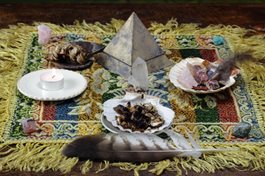
So much of Cuban culture is a unique fusion of the different traditions of her population: the indigenous people, and the immigrants to the country, the Spanish settlers and African slaves. Nowhere is this more prevalent than in Santeria, the country's popular syncretic religion. This fusion of African Yoruba mythology and Roman Catholic beliefs dates back five hundred years in Cuba, from where it spread throughout the rest of the Caribbean, particularly after the 1959 revolution. Today, Santeria is gaining popularity in North America, its appeal lying in both its mystical roots and powerful visceral experiences, but also because it is a non-hierarchical, inclusive community that welcomes people of any gender, sexual orientation, or other faith belief systems.
"Santeria" or "saints' worship" is a pejorative term given to the emerging religion in the early sixteenth century by Spanish settlers, but the name tells us much about the origins of the fusion faith. This era saw the mass expansion of sugar cane exports from the New World to Europe, which involved the backbreaking work of tens of thousands of African slaves. To the Spaniards, these slaves from Benin, Toga, Senegal, Congo, and Nigeria might have seemed a homogenous group, but in actual fact the slave population of Cuba was made up of some 26 different races, who spoke almost 120 distinct dialects and languages. The slave quarters of the island were a mini Tower of Babel, but the one thing that united this disparate and desperate group was the complex religion of their home continent. This became the force that united them, but also endangered them: baptized by their Spanish owners, the slaves were forced to conceal their native rituals, masking them in the veneration of Catholic saints. The settlers mocked the slaves, believing them to be too simple-minded to understand the more complex Christian doctrines.
If anything, the slaves' religion was far more nuanced than sixteenth-century Catholicism. Rooted in the belief that human beings have a pre-ordained destiny, the benign creator of the universe, Olodumare is accessed via the all-important Orishas, powerful, but mortal spirits, who act as manifestations of the divine. Through sacrifice and adherence to ritual, the faithful petition the Orisha for assistance and guidance in navigating a path towards their true destiny, for healing, and for renewal. The faithful believe the Orisha respond to animal sacrifice, drumming, singing, and speaking and eating with the spirits.
Over the centuries, specific Orisha have been "paired" with Catholic saints with whom they share obvious attributes: Saint Barbara, for example, is the alter-ego of the Orisha Shengo. Both embody justice and strength, and are associated with fire and lightening. St. Lazarus, who traditionally hears the prayers of the sick, is twinned with Babalu, widely acknowledged as the protector of sufferers from smallpox, leprosy, and more recently, HIV/AIDS.
Devotees of Santeria also mix and match rituals: a popular cleansing rite includes a ritual herbal bath, followed by the recitation of three Our Fathers, three Credos, and three Ave Marias.
Discover Cuba's unique heritage on one of Alexander + Roberts carefully crafted itineraries to the island nation, such as
Classic Cuba, which visits Trinidad, one of the leading centers of Santeria worship.